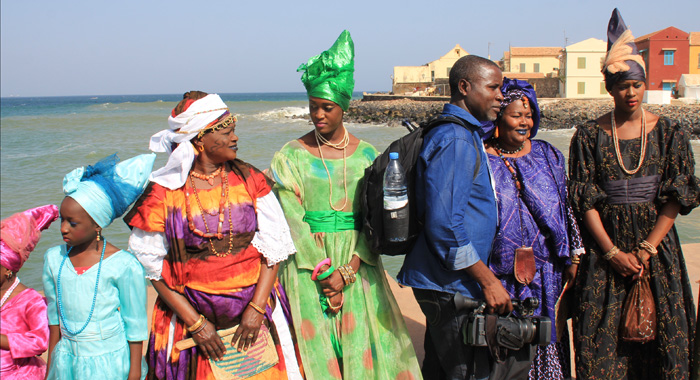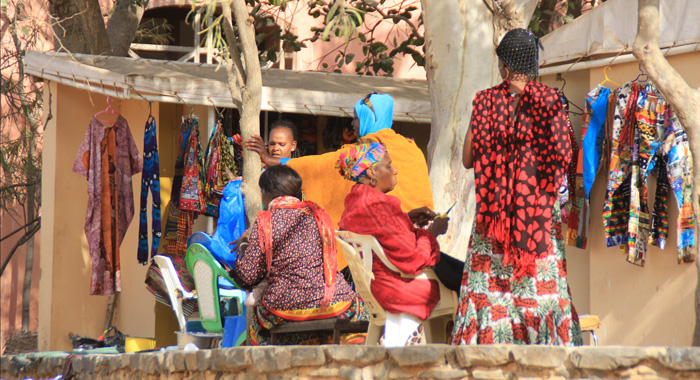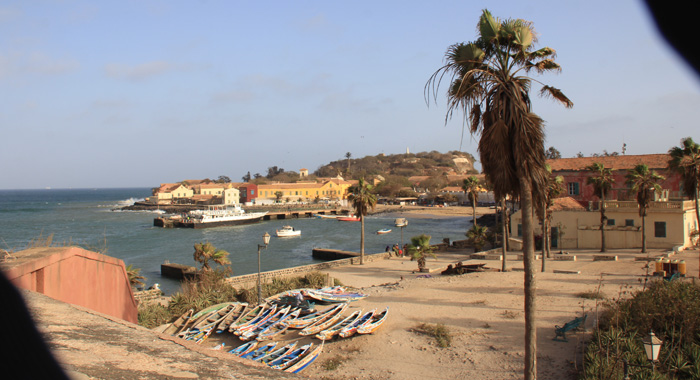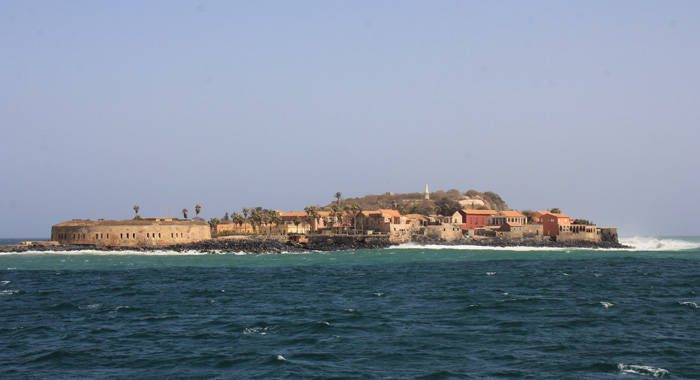By Kenton X. Chance
DAKAR, Senegal (CMC) — Belize’s ambassador to the European Union, Dylan Vernon, was excited about coming to West Africa for the first time, but it was not just about his diplomatic mission.
He had come to Senegal to attend the 103rd meeting of the African, Caribbean and Pacific (ACP) Council of Ministers and also to participate in the joint ACP-European Union meeting.
But, the diplomat, like other delegates and journalists, mainly from the Caribbean, took the opportunity to visit the island of Gorée, a transhipment point for African slaves for almost four centuries.
“Coming here brings back a lot of my feelings about the fact that my country is one of those that was built on the slave trade,” Vernon told the Caribbean Media Corporation (CMC) during his tour of the 28-hectare island, which the United Nations Educational, Scientific and Cultural Organization (UNESCO) says was the largest slave-trading centre on the African coast from the 15th to the 19th century.
“Belize, as the rest of the Caribbean and parts of the Americas, was a place where slaves were taken and I myself, have ancestors who were slaves. And to come to a place like this that could be where some of my ancestors came from, brings some emotions,” Vernon said, visiting also the only surviving slave house on the island, located 3.5 kilometres from Dakar.
During the visit, Vernon said he experienced “mixed emotions, both of interest in historical facts and a great personal sense of the feeling where my ancestors could have come from and what sort of destruction of families happened to make the journey across the Atlantic”.

Although UNESCO declared Gorée a World Heritage Site in September 1978, historians are not agreed on the role it played in the slave trade.
But one undisputed historical fact is that many Africans were ripped from their homes across West Africa and shipped from Gorée to the Americas. Some estimates say that 20 million Africans passed through the Island between the mid-1500s and the mid-1800s.
“Because Gorée is an island, the slaves couldn’t escape from here,” a guide tells the visiting delegation, which included descendants of slave and slave masters.
“But half of the slaves died because … it took them 10 to 12 weeks to get to their destinations — Brazil, Haiti, Cuba and the rest of the West Indies,” the guide quickly adds.
Since Gorée is a World Heritage Site, construction of new buildings or demolition of existing structures is prohibited.

Among the buildings is the Slave House, which offers visitors an insight into the conditions in which Africans were kept before they were transhipped to the Americas, mainly to Cuba, Haiti and Brazil, before further “distribution”.
There were initially 20 slave houses on the island, the first of which was built by the Portuguese in 1536.
The only remaining slave house was built by the Dutch in 1776.
Before the World Heritage Site declaration, the other slave houses had been remodelled and converted to private homes for the island’s inhabitants, 1,200 of whom live there today.
The slaves were housed in rooms mere 2.6 meters (8.5 feet) square .
“But, inside, they put 15-29 persons,” explains M. Eloi Coly, chief curator of Gorée, adding, “They sat with their backs against the wall, shackled around the neck and the arms.”
The slaves were freed once a day.
“It was just to permit them to go outside to relieve themselves,” Coly says, pointing to a small sink directly in front of the entrance to the slave house.
“They lived inside in such bad sanitary condition that the first plague epidemic that ravaged the island of Gorée in 1779 began in a house like this…
“Children normally laid down on the floor like fishes in sardine boxes, which contributed to high death rate,” Cory said, noting the role the slave houses played in not just curtailing the physical liberty of the slaves.
“Importantly, in the slave houses began the destruction of the family structure, because the destination of the slaves depended on the buyer. That is why father could be sent to Louisiana, mother to Brazil, children to Haiti or the West Indies. So, the separation was total,” Coly said.
He said that “rebellious slaves” were placed in the “cellule de recalcitrants”– a narrow space under the stairs from the ground to upper floor.
“They used it as a punishment of slaves. But the problem for the guards was not to know how many slaves it was possible to put inside at the same time. It was just how to shut the door after forcing in the captives, because they considered the captives not as human beings, but as merchandise,” Coly recounts of the space reserved for “recalcitrant” slaves.

When it was time to ship the slaves to the Americas, they left the slave houses and Gorée through what is now known as “The Door of No Return”, catching their final glimpses of their homeland.
“After the slaves stepped out of the door, it was bye-bye Africa,” the curator said, adding that they were loaded into canoes and taken to the slave ships anchored further out at sea.
St. Vincent and the Grenadines Deputy Prime Minister, Louis Straker, who was among the dignitaries on the tour, also shared his reflections after standing in “The Door of No Return”.
“This is the door. Goodbye to the home that our forefather lived in happiness, lived in freedom. From here, they become slaves on to different part of the world — families separated and they become totally alienated from their homeland. Thank God I am back to bring back the spirit, and I hear their cries,” said the senior politician, who is also Minister of Foreign Affairs and Foreign Trade.

Today, Gorée is home to an estimated 1,200 Senegalese people, the French, the last colonisers of the island, having left when Senegal gained independence in 1960.
The main activity on the island is tourism, followed by fishing.
Most people on the island are guides, vendors and restaurateurs and 50 per cent of the island’s visitors come from France, with the remainder originating from Africa and the Americas.
Prominent visitors to the island have included the late president of South Africa and anti-apartheid fighter, Nelson Mandela and the United States President Barack Obama.
Among the monuments on the island is a palm tree planted December 5, 2014, marking the first anniversary of Mandela’s death.

In 2002, Guadeloupe donated to Gorée “La Statue de la Libération de L’esclavage”, a monument from that French Department in commemoration of the slave trade.
But Gorée itself is a memorial to the Black Diaspora.
Vernon says that the island brings back “some feeling of anger towards those who did it (enslaved Africans) — the Europeans of various nationalities and it brings back also memories of my own history of Belize, where slaves were used to build the economy.”
He said that while it might not be possible to establish the ties directly, history shows that some of the slaves that went to Belize came from West Africa.
“Exactly which parts and how, that story still has to be written to some extent but the fact is that Belize is one of the places where slaves were taken — by the British in this case, and they could have indeed come from West Africa,” he tells CMC.







Great human interest reporting, as usual, Kenton.
Too bad though that Sir Louis is deaf to the cries of his own people who have suffered under the wickedness of his ULP government for these past 15 years.
Too bad also that Dylan Vernon refuses to acknowledge or vent his anger towards the indigenous Africans who gladly participated in the slave trade by hunting down members of other tribals groups, putting them in chains, and selling them to other Africans or Europeans to satisfy their greed or inter-ethnic hatred.
Kenton I am somewhat surprised that you would put your name to this article its so full of untruths and its very misleading.
Gorée is famous as part of the Atlantic slave trade but relatively few slaves were processed or transported from there. The more important centres for the slave trade from Senegal were further north, at Saint-Louis, Senegal, or to the south in the Gambia, at the mouths of major rivers for trade.
Gorée and these French ports in general shipped slaves to the French colonies via France.
The Portuguese were the first to establish a presence on Gorée c.?1450, where they built a small stone chapel and used land as a cemetery.
Gorée is known as the location of the Maison des esclaves [house of slaves], built by an Afro-French Métis family about 17801784.
Gorée was relatively unimportant in the slave trade. Probably no more than a few hundred slaves per year departed from here for transportation to the Americas. They were more often transported as incidental passengers on ships carrying other cargoes rather than as the chief cargo on slave ships. After the decline of the slave trade from Senegal in the 1770s and 1780s, the islands town became an important port for the shipment of peanuts, peanut oil, gum arabic, ivory, and other products.
The island of Gorée was one of the first places in Africa to be settled by Europeans, as the Portuguese settled on the island in 1444. It was captured by the United Netherlands in 1588, then the Portuguese again, and again the Dutch. They named it after the Dutch island of Goeree, before the British took it over under Robert Holmes in 1664.
After the French gained control in 1677, the island remained continuously French until 1960. There were brief periods of British occupation during the various wars fought by France and Britain. In 1960 Senegal was granted independence. The island was notably taken and occupied by the British between 1758 and 1763 following the Capture of Gorée and wider Capture of Senegal during the Seven Years’ War before being returned to France at the Treaty of Paris (1763). For a brief time between 1779 and 1783, Gorée was again under British control, until ceded again to France in 1783 at the Treaty of Paris (1783). During that time, the infamous Joseph Wall was Lieutenant Governor there, who had a man unlawfully flogged to death in 1782. The island was best described as a general trading post not a slave centre.
https://en.wikipedia.org/wiki/Gor%C3%A9e
Your reference to 20 million slaves passing through the island facilities is grossly wrong. In fact there has been a war of words raging for years since the curator and guides of the facility was found to be telling elaborate stories about happenings and slave numbers which are generally untrue.
I doubt very much that many if any slaves arrived at Belize from Gorée.
Kenton this statement by you is totally fictitious But one undisputed historical fact is that many Africans were ripped from their homes across West Africa and shipped from Gorée to the Americas. Some estimates say that 20 million Africans passed through the Island between the mid-1500s and the mid-1800s.
Africans were never ripped from their homes across Africa to support any part of the Atlantic Slave Trade. That kind of untruth feeds into the school system and fills the minds of children and ignorant uneducated adults with fiction instead of the truth.
Africas countries have run on a slave system for thousands of years, there were whole sections of the populace who were born into slavery as their parents and grandparents had been. Warring tribes and kingdoms captured those that they warred against and made them slaves. Chiefs and kings manacled and sold people who were criminals or considered antisocial or even just those who they didnt like. Later the chiefs and kings captured whoever they could to sell into what became virtually their source of immense wealth. White people never went into the desert, the jungles and the villages snatching people that is absolutely untrue.
The Atlantic slave trade started as a sideline to a slave trade that had been going on for centuries between the Africans and the Arabs. It started when Antonio Gonsalves captured Africans on a beach and took them to Lisbon where they were delivered to Prince Henry of Portugal, who sent them as a gift to the Roman Catholic Pope. Gradually that developed into a massive trade in the Americas and Caribbean which for 200 years the Portuguese and Spanish controlled the trade after the Pope divided the World into two giving half to the Portuguese and half to the Spanish with the instruction that any person who they found who was not a Christian could be enslaved.
I think you took most of your content from the publication Africana The Encyclopedia of the African and African American Experience, or from http://www.aaregistry.org/historic_events/view/goree-island-home-door-no-return
But wherever you got it from it is untrue and misleading to say the least.
The total slaves shipped between 1519 and 1867 was around 12 million, so to say that 20 million were shipped from Gorée Island alone tells its own story.
Of those 12 million the countries below were responsible for shipping and trading those people.
Portuguese America 38.5%
British America (minus North America) 18.4%
Spanish Empire 17.5%
French Americas 13.6%
British North America 6.45%
English Americas 3.25%
Dutch West Indies 2.0%
Danish West Indies 0.3%
African slavery is running out of control again in parts of Africa today.
Peter, when your comments are based on accurate and verifiable data, all I can do is congratulate you — as I do here — for enlightening our brainwashed people.
The Atlantic slave trade would not have happened without the active involvement and encouragement of the West and Central African people, none of whose countries are being asked for any reparations for what is now seen as a heinous crime against their brothers and sisters but was perfectly legal and moral (at least in Africa) at the time and which is seen as perfectly moral (but illegal or extra-legal) in many African countries today.
Without African slavery, the Caribbean sugar industry would still have prospered, albeit at a slower pace, using European and Asian indentured and wage labour. It has long been asserted by economists and historians that this might have been more economical than using slaves because of the deliberate low productivity of the latter.
There is ample evidence that Sir Louis comes from a black Vincentian family who kept slaves in Saint Vincent and there is even record of a transaction where Nanny Straker gave a slave to her daughter is a gift.
Feoffment [grant of ownership] of two slaves: Nanny Straker, a free coloured woman of Saint Vincent, has enfeoffed [given] to her daughter Polly Melville a female slave and her daughter.
Ref: Public Records SVG, Record # f. 288 Entered 22 July 1809
The president of the West African nation of Benin sent a message for African-Americans: His compatriots are sorry for their ancestors complicity in the slave trade.
During December 1999, hes going to tell them that at a special Leadership Reconciliation Conference on his soil [and he did].
Benin president Matthieu Kerekou says intertribal hostility over the slave trade still exists. Many of his people have never seen descendants of their forebears who were shipped off to the Americas.
Kerekou attended the National Prayer Breakfast in Washington last February 1999 and sought African-American church leaders to whom he could apologize.
https://www.probe.org/west-africans-to-african-americans-we-apologize-for-slavery/
There are number of African leaders who have apologized, but not Ralph he has not apologized.
Despite having recent ancestors that kept slaves Sir Louis has stayed quiet as well, not a peep certainly no apology.